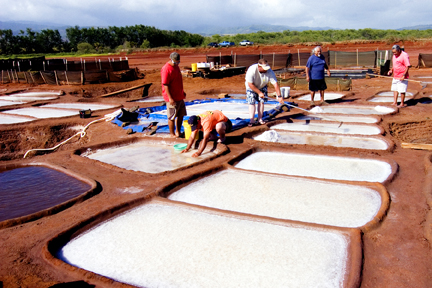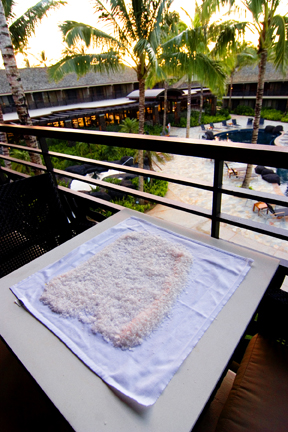Like I said, about the only things I ever bring home from my trips are drink recipes and sea salt. So how excited do you think I was when I found out that just up the coast from where I’m staying in Kauai are salt ponds where Hawaiians have been harvesting sea salt since before Captain James Cook landed near what is now Waimea in 1778?
From what I’d heard, the salt ponds near Hanapepe are one of only two remaining in Hawaii where natural sea salt is still harvested (the other is on the Big Island).
Having actually harvested sea salt on the island of Ile de Ré in France, I was a little surprised to see the ponds on Kauai. First of all, it’s a very small area. There were maybe two dozen small ponds, each about the size of a hot tub. I’d say the entire area would easily fit inside one single pond on Il de Ré. And the process is different. In France, the ponds are in estuaries where the tides control the water, moving it from the higher dikes to the lower ones in a slow process that increases the salinity of the water at each step.
On Kauai, the ocean water passes through salt water aquifers that feed wells called punawai. From here the water is either pumped or, using buckets, carried into ponds that are like shallow bath tubs, called wai ku (literally “water standing”) shaped by hand into the red clay soil. For several weeks the water is allowed to evaporate (they only harvest the sea salt during the summer) until a slushy layer of crunchy salt crystals form. This is then slowly raked into big mounts before being collected in 5-gallon buckets.
But the most interesting thing about all this is that this isn’t a commercial operation. In fact, it’s illegal to sell Kauai’s sea salt because Hawaiians have always considered it a gift from the sea (that said, it can be bartered). The other cool thing is that only a handful of locals—families who have been farming the sea salt for many generations—are allowed to work the salt ponds. In short, this is kind of like a sacred area (after the salt has dried, a small percentage of it is mixed with red volcanic soil, usually from secret valleys inland, and that red salt, called alaea, is considered sacred and is used for healing remedies that call for purification ceremonies. The alaea Hawaiian red sea salt you pay a fortune for at your local gourmet store is a commercial product that has nothing to do with the actual harvesting of Hawaiian sea salt).
The salt ponds, which are adjacent to Salt Pond Park, one of the best snorkeling beaches on the island, are marked off by green wind fences but that doesn’t keep tourists from just wandering in and sticking their hands or feet in the ponds which, as you can imagine, sort of drives the Hawaiian saltmakers crazy. It’s like having a vegetable garden where people come in off the street to squeeze your tomatoes.
But if you ask for permission to come inside the fence, they’re usually more than happy to accommodate you and let you take pictures and ask a few questions. Which is what I did. I started yacking with this old Hawaiian guy, Dwight, who was collecting salt with his grandson. He told me how they got the water and how they made the ponds by massaging the red clay with a smooth stone until it formed a waterproof pool and how, in summer, his family, which has been doing this for so long no one can even remember when they first started, might get three harvests in a season, giving them some 200 pounds of salt.
“What do you do with all that salt?” I asked him.
“Lots of things,” he said. “Some for alaea is used for blessings and such. Mostly though we rub it on kalua pig or fish.”
I asked him how long 200 pounds of salt would last and he shrugged and said about a year. “But we give lots away,” he said. “Anyone need some alaea, they come to me.”
Maybe he saw the glint in my eye because he asked me if I wanted some. “You got a bag?” I ran back to the car and grabbed a plastic grocery bag and Dwight started shoveling in handfuls of fresh salt crystals. I think he would have filled it up if I’d have let him, but I told him it was more than enough. He told me the salt was still wet and needed to be spread out in the sun to dry before I took it home. So I went back to my hotel, the Ko´a Kea, and dumped my salt onto a cloth napkin and spread it out on the little table on my balcony overlooking the pool.
Later, I was having a Red Coral cocktail with the hotel GM, Chris Steuri, in their restaurant which happens to be called Red Salt and told him about my gift of salt and how I was trying to dry it out on my balcony.
“Let me take care of it for you,” he said. He sent someone up to my room to collect the salt and bring it down to the kitchen where the chef, Ronnie Sanchez, dried it and then vacuumed-packed it for me. A cocktail waitress came by and handed me the sealed pack of freshly-harvested sea salt while I was still working on my Red Coral martini. The bag now sits like a precious trophy on the bed in my room. So now I have my two island souvenirs: the recipe for a Red Coral and a bag of Kauai sea salt. Lovely.
-
Did you ever get the family name of the salt harvesters? We stopped there and talked to an old woman who was tending to her salt ponds and she gave us a bag full of salt she had previously harvested.
Comments are now closed.



5 comments